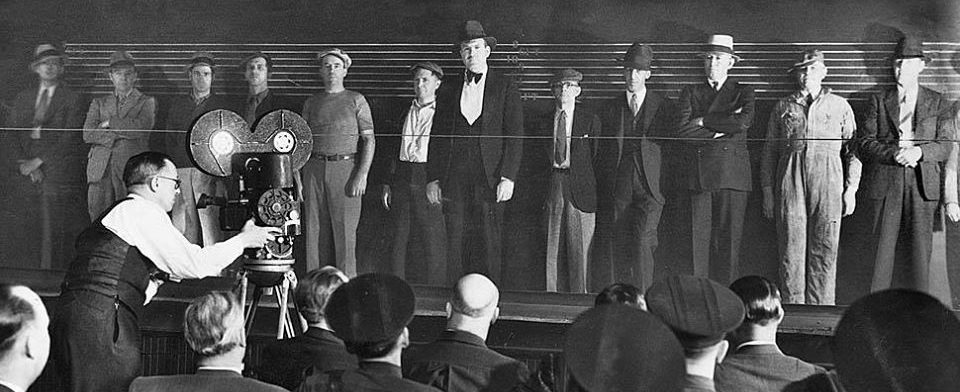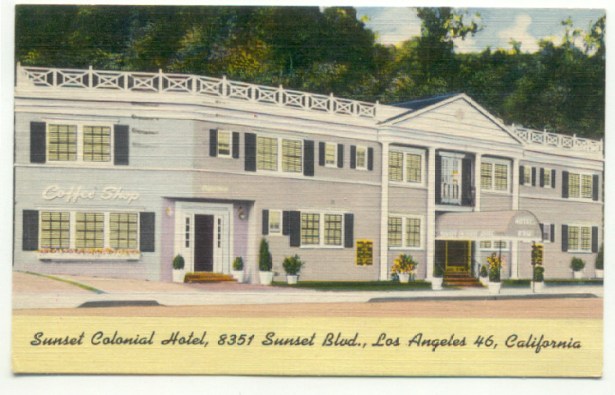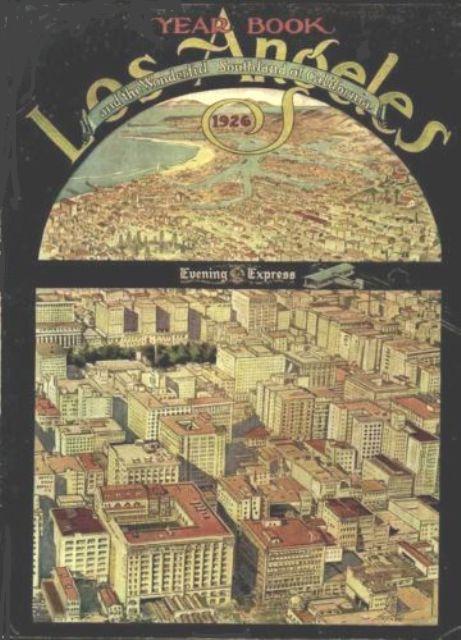Many hotel projects proposed for Hollywood Boulevard in the 1920s were much hyped but never built- for example the Brokaw property, the Bartlett property, and the Shippee property. The Regent Hotel, on the south side of Hollywood Boulevard in the midst of Auto Row between El Centro and Argyle, did get built. It came along without fanfare, announced in the LA Times in September 1924.
Designed by architects Meyer and Holler, the 85-room, 4-story plus penthouse structure was built for the Christie brothers, who had a realty business as well as a film studio. the hotel rose on the site of a former orange orchard where the Nestor Film Company– with Al Christie, manager, had made some of the earliest motion pictures in Hollywood.
The Regent had its gala grand opening on April 29, 1925. A notable feature was that each room had a radio; connected to a central operating system at the room clerk’s desk, they could pick up local programs.
With its proximity to the early Hollywood movie studios, the Regent Hotel became popular with theatrical folk- as local papers would later put it- either on their way up or on their way down. It had become rather shabby by November 1949, when it was purchased by Ethel McCord Nelson and her son John McCord. McCord remodeled the hotel and renamed it the Hotel Gentry.
Ethel McCord owned the Hastings Hotel in Minneapolis at this time. As she was taking on the former Hotel Regent in Hollywood, Ethel also faced federal tax evasion charges back in Minnesota for the years 1940-1945. She was convicted in 1950 and was to have done a prison term but in December 1950, the sentence was changed to a fine and 5 years probation. She married Paul A. Nelson in Minneapolis in June 1950.
While cleaning, Ethel found an Oscar in a closet; the statuette had no identifying information on it, nor could McCord trace the owner through the hotel records, as she could not later recall which room she had found it in.
The hotel remained the Hotel Gentry into September 1954. In October 1954, it was taken over by Irene Vermillion Dart and her husband Kermit Dart and renamed the Hotel Vermillion.
The Darts were something of a real life Fred and Ethel Mertz, retired Vaudevillians managing an apartment house. Irene, as Irene Vermillion, was a stage dancer; Kermit was a musician. The two continued to perform occasionally even after becoming landlords.
The hotel remained the Hotel Vermillion until August 1959, when Ethel McCord Nelson took it over again, renaming it the Hotel Hastings.
The Hotel Hastings was the name of the hotel in Minneapolis that Ethel had managed from 1936 to 1943, when she purchased it from the Arthur Roberts Hotel Company. She sold the Minneapolis Hastings in late May-early June 1959.

Ethel McCord managed the Hotel Hastings and The Parkway in Minneapolis. She married Edward R. Johnson in 1937; they divorced in May 1940. Minneapolis Star Journal 6/23/1940.
Eating and Drinking here
The hotel’s first restaurant opened shortly after the hotel itself, in June 1925 as the Hotel Regent Restaurant.
On March 24, 1927, ex-boxer / dentist Leach Cross opened a namesake cafe, the “Leach Cross Cafe” in the hotel’s ground floor retain space, addressed as 6160 Hollywood Boulevard.
Like most such Leach Cross ventures, the cafe was short lived.
On March 9, 1928, 616o Hollywood Boulevard opened as McHuron’s Grill with almost as much fanfare as the opening of the hotel itself.
McHuron’s Grill was founded by Loren A. McHuron and Charles Eaton. Both had been previously affiliated with the Paulais Cafe at Hollywood Boulevard and Las Palmas. The grill featured a German chef. The specialty of the house became a dish called “Toad in the Hole,” which McHuron’s claimed had originated there, and that it had a copyright. It was an old English specialty, so this is questionable. There are many varied recipes for Toad in the Hole- typically it involves a clump of sausages grilled with an egg in the center. So famed was the cafe for this dish that by the early 1930s, “Toad in the Hole” featured prominently in the grill’s print advertising as well as a neon vertical sign on the outside of the building.
Charles Eaton left the partnership in 1935 to found his own namesake Easton’s chain of restaurants. L. A. McHuron carried on with the grill until 1940. The equipment and fixtures were sold at auction in July 1940. McHuron died in 1941.
In 1952, Joe’s Cuba Club operated in the former grill space, serving Italian dinners in addition to American fare.
The Hotel Gentry also still had a hotel dining room.
During its time as the Hotel Vermillion, the hotel dining room became the Dart-Inn Room, with a twin organ bar. Kermit Dart was a talented organist.
In 1959, the grill space became the Cart Inn, offering German, Irish and Italian fare. The chef had been there during McHuron’s time, so likely Toad in the Hole could be ordered off-menu.
In 1962, it was a wine bar called The Tender Grape.
In 1964, the Hollywood USO moved into 6160 fro mthe Pantages Theater building, on what was supposed to be a “temporary” basis that lasted into the 1970s.
The hotel remained the Hotel Hastings into 1993. The building was demolished in 1994.
Toad in the Hole










































































